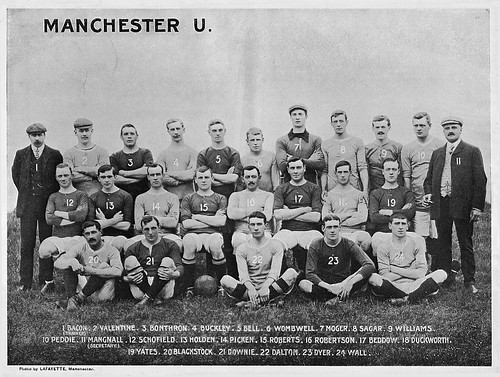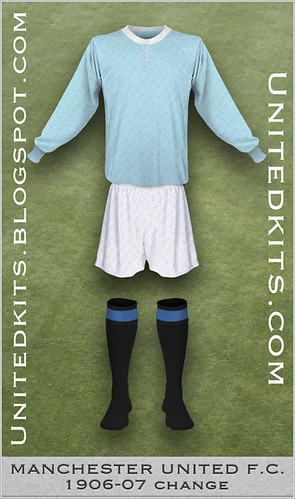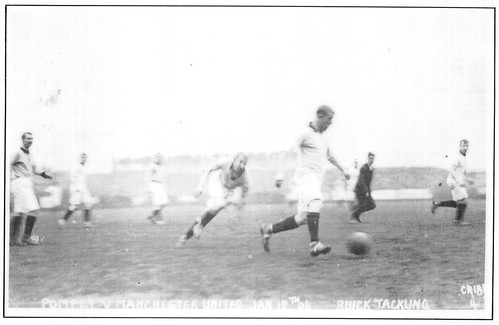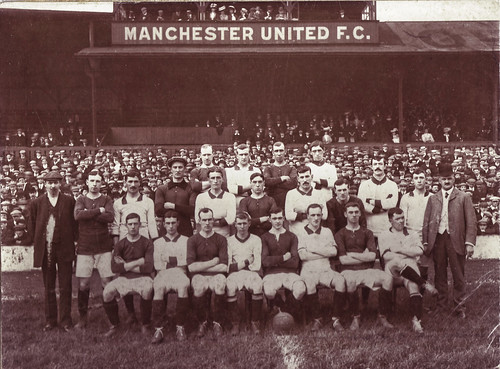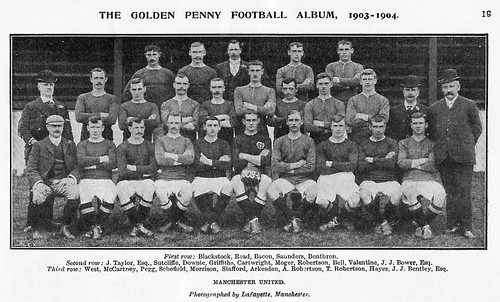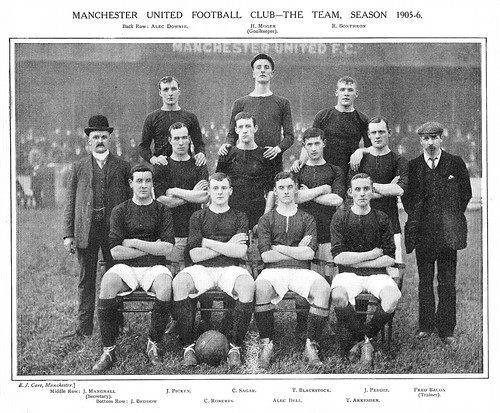Shortly after returning from the club's first international tour, where players and officials had been stoned by opposition fans after a 7-0 win in Hungary, United took part in the newly rejigged FA Charity Shield, where they faced the winners of the Southern League, Queens Park Rangers at Stamford Bridge. It was a 1-1 draw, but United won the replay 4-0, with Jimmy Turnbull scoring a hattrick. They wore their usual home kits for both games.
The team line up for the start of the 1908/09 season, with their haul, the Charity Shield, the League Trophy and the Manchester Cup (click any of these images for higher res):
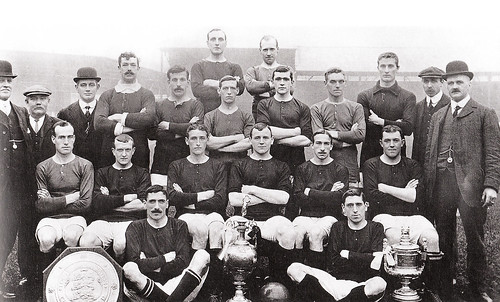
The team photographed before a public practice match at the start of the season:
 This is an edited version of an image from the extensive Leslie Millman collection, which can be found at www.flickr.com/photos/manchesterunitedman1/ and is used with full permission.
This is an edited version of an image from the extensive Leslie Millman collection, which can be found at www.flickr.com/photos/manchesterunitedman1/ and is used with full permission.
In the league, United were unable to replicate their success of the previous season, finishing in a disappointing 13th place. They also lost their record for most points in a season to Newcastle, who beat it by a single point. They were to have more luck in the cup, however.
The campaign began at home to Brighton and then Everton. Both games finished 1-0 with Harold Halse scoring both goals. Then came Blackburn, also at home, who were thrashed 6-1, with hattricks each from Sandy Turnbull and Jimmy Turnbull (no relation).
United were through to the quarter-finals, which was as far as they had ever got in the competition previously, and were drawn away to Burnley. With only 18 minutes of the match to go and losing 1-0 it looked as if they were again destined to go out in the last eight, but for a blizzard to save them as the referee was forced to abandon the match.
Legend has it that referee Herbert Bamlett's lips were so cold he could not blow the whistle to end the match so Charlie Roberts had to blow time himself. Oddly, that wasn't to be the last United would see of Bamlett, as he would become their manager in the late 1920s.
The replay was a thrilling 3-2 win for United and in the semi-final they beat cup-holders Newcastle 1-0 at Bramhall Lane, with the goal coming once again from Halse.
The final was to take place four weeks later, on Saturday, 24th April 1909 at Crystal Palace against Bristol City.
United were to face their cup-final opponents in the League just twelve days before the showpiece, and they were held to a goal-less draw at Ashton Gate, where they were photographed in white lace-neck shirts with a red "V" on the chest. Note that goalkeeper Harry Moger is wearing the same kit as the outfield players. This was common practice until the FA allowed keepers to wear different shirts from their teammates the following season:
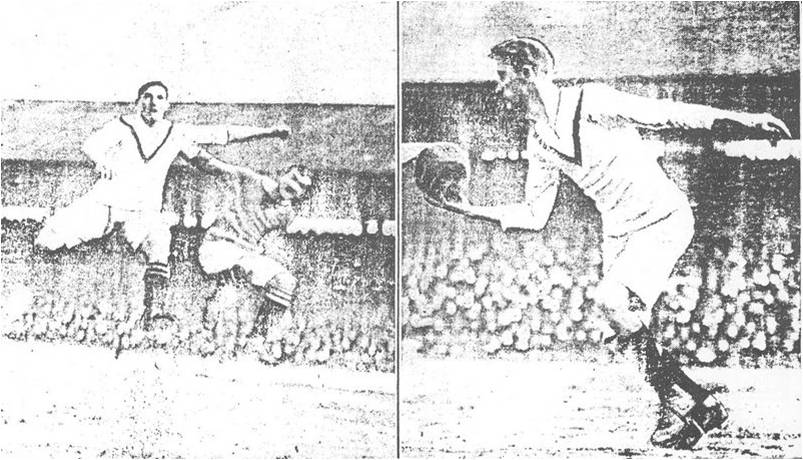
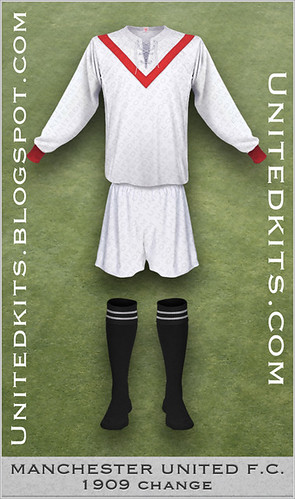
These kits are commonly thought to have been worn only in the final - albeit with the addition of a badge with the red rose of Lancashire on the chest - but the images above show that is not the case. It is unknown whether they were worn for any other matches, however. The shirts are also said to have been purchased from Billy Meredith's sportswear shop in St Peter's square (the site of which was cleared to make way for the Town Hall extension and Central Library in the 1930s). The shorts were white and the socks appear to have been black with a white band between two red bands on the turnovers.
The programmes were quickly printed up:
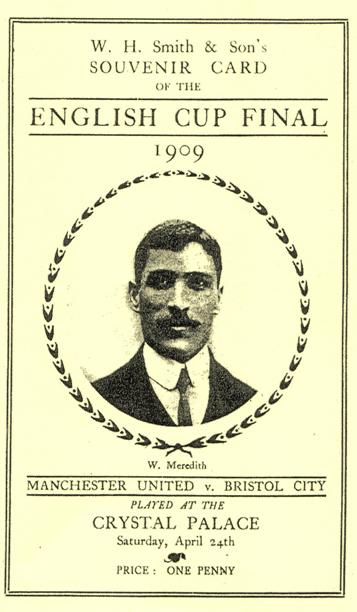
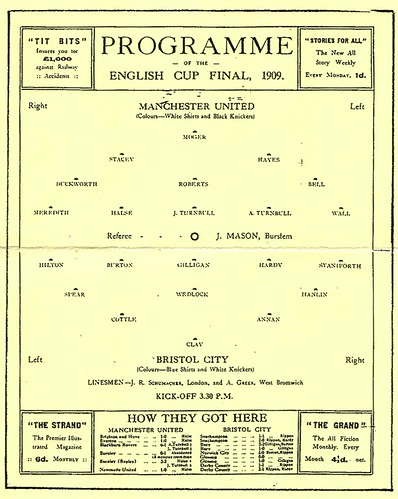
Shortly before the Cup Final, popular music-hall star George Robey presented the team with their kits - now adorned with the red rose. Although one or two United players are pictured in socks with white hoops on the turnovers, the majority wore plain black socks without hoops:

Here's a colourised version:
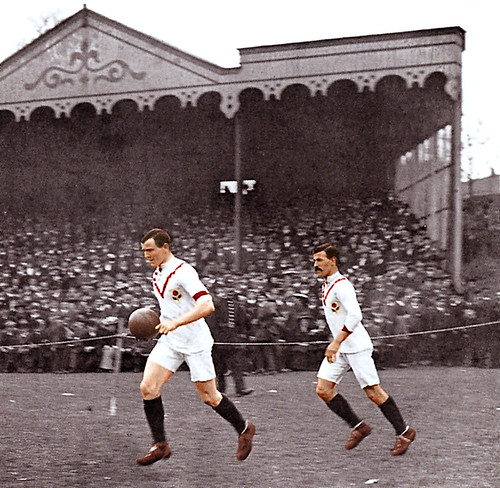
In front of a crowd of over 70,000 the game kicked off. Apparently it started brightly and after 22 minutes, United went ahead, with Sandy Turnbull (who was struggling with a knee injury that would have kept most on the sidelines) turning in a rebound from a Halse shot. It was the only goal of the game.

Billy Meredith's shirt from the match, on display at the club museum:
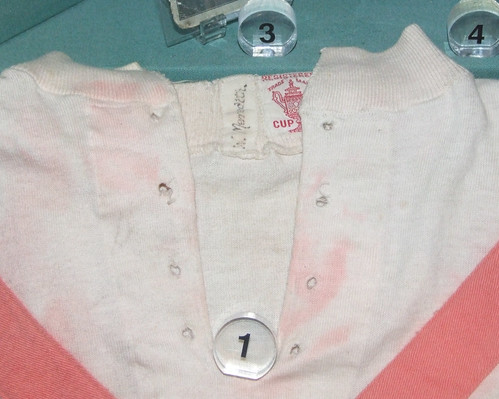
Sandy Turnbull's cup final shirt - missing its badge and in poor condition - on display at the museum:

They returned home to Manchester on the following Tuesday, arriving at Central Station before making the short trip over to Albert Square for a reception at the Town Hall where they were greeted by thousands of cheering supporters:
Incredibly, they then had to travel across town to Clayton for a match against Arsenal, where 30,000 fans awaited, where they inevitably lost. Despite this, the Arsenal players were invited to join in the continuing celebrations with the United team.
100 Years On...
To mark the centenary of the final, supporters of United and Bristol City organised a
rematch - which took place exactly 100 years to the day, at the exact time and on the same ground as the original. United won 2-1.
Nike have said that they will use the designs of the shirts worn in the historic match as inspiration for the 2009-10 kits.




